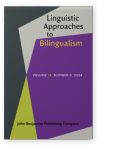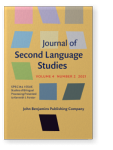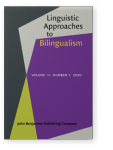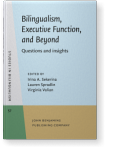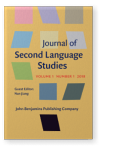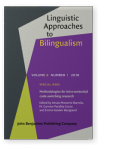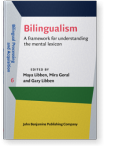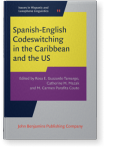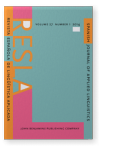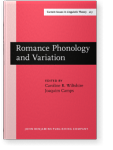Paola E. Dussias
List of John Benjamins publications for which Paola E. Dussias plays a role.
Journal
2024 Heritage speakers’ processing of the Spanish subjunctive: A pupillometric study Linguistic Approaches to Bilingualism 14:6, pp. 809–855 | Article
We investigated linguistic knowledge of subjunctive mood in heritage speakers of Spanish who live in a long-standing English-Spanish bilingual community in Albuquerque, New Mexico. Three experiments examine the constraints on subjunctive selection. Experiment 1 and Experiment 2 employed… read more
2021 Of revistas and magacínes: Lexical competition in the online processing of established loanwords Studies of Bilingual Processing Presented to Kenneth I. Forster, Jiang, Nan (ed.), pp. 375–411 | Article
The transfer of words from one language to another is ubiquitous in many of the world’s languages. While loanwords have a rich literature in the fields of historical linguistics, language contact, and sociolinguistics, little work has been done examining how loanwords are processed by bilinguals… read more
2020 When actions and looks don’t line up: The contribution of referential and prosodic information in the processing of PP ambiguities in child-L2 speakers of English Linguistic Approaches to Bilingualism 10:5, pp. 623–656 | Article
In two eye tracking experiments, we investigate how adult child-L2 speakers of English resolve prepositional phrase (PP) attachment ambiguity in their dominant language (English), and whether they use prosodic information to aid in the process of garden-path recovery. The findings showed an… read more
2019 Chapter 4. Adaptive control and brain plasticity: A multidimensional account of the bilingual experience and its relation to cognition Bilingualism, Executive Function, and Beyond: Questions and insights, Sekerina, Irina A., Lauren Spradlin and Virginia Valian (eds.), pp. 49–66 | Chapter
A central question in cognitive neuroscience concerns how individuals’ cognitive abilities are shaped by learning from experience. This paper presents a critical overview of the discoveries that have emerged from the study of bilingualism, and the implications that they hold for language,… read more
2018 Grammatical gender processing in L2 speakers of Spanish: The role of cognate status and gender transparency Journal of Second Language Studies 1:1, pp. 5–30 | Article
Recent findings indicate that native speakers (L1) use grammatical gender marking on articles to facilitate the processing of upcoming nouns (e.g., Lew-Williams & Fernald, 2007; Dussias, Valdés Kroff, Guzzardo Tamargo, & Gerfen, 2013). Conversely, adult second language (L2) learners for whom… read more
2018 Experimental contributions of eye-tracking to the understanding of comprehension processes while hearing and reading code-switches Methodologies for intra-sentential code-switching research, Munarriz-Ibarrola, Amaia, M. Carmen Parafita Couto and Emma Vanden Wyngaerd (eds.), pp. 98–133 | Article
Researchers who study code-switching using lab-based approaches face a series of methodological challenges; these include, but are not limited to, using adequate techniques and tasks that allow for processing that reflects real-language usage and selecting stimuli that reflect the participants’… read more
2017 When cognate status produces no benefits: Investigating cognate effects during the processing of code-switched sentences Bilingualism: A framework for understanding the mental lexicon, Libben, Maya, Mira Goral and Gary Libben (eds.), pp. 143–180 | Chapter
Experimental studies examining the production and comprehension of language switches have provided evidence for a subtle but significant “switch cost:” switched words take longer to process than non-switched words (e.g., Altarriba, Kroll, Sholl, & Rayner, 1996; Gollan & Ferreira, 2009; Gollan,… read more
2017 Experience with code-switching modulates the use of grammatical gender during sentence processing Linguistic Approaches to Bilingualism 7:2, pp. 163–198 | Article
Using code-switching as a tool to illustrate how language experience modulates comprehension, the visual world paradigm was employed to examine the extent to which gender-marked Spanish determiners facilitate upcoming target nouns in a group of Spanish-English bilingual code-switchers. The first… read more
2016 Comprehension patterns of two groups of Spanish-English bilingual codeswitchers Spanish-English Codeswitching in the Caribbean and the US, Guzzardo Tamargo, Rosa E., Catherine M. Mazak and M. Carmen Parafita Couto (eds.), pp. 301–322 | Article
Current knowledge of the mechanisms underlying the production and comprehension of codeswitches derives largely from studies with bilingual speakers who do not codeswitch or who report codeswitching (CS), but do not belong to stable bilingual communities. Although these data have a place in CS… read more
2014 Processing ser and estar to locate objects and events: An ERP study with L2 speakers of Spanish Revista Española de Lingüística Aplicada/Spanish Journal of Applied Linguistics 27:1, pp. 54–86 | Article
In Spanish locative constructions, a different form of the copula is selected in relation to the semantic properties of the grammatical subject: sentences that locate objects require estar while those that locate events require ser (both translated in English as ‘to be’). In an ERP study, we… read more
2002 On the relationship between comprehension and production data in codeswitching Romance Phonology and Variation: Selected papers from the 30th Linguistic Symposium on Romance Languages, Gainesville, Florida, February 2000, Wiltshire, Caroline R. and Joaquim Camps (eds.), pp. 27–38 | Article
